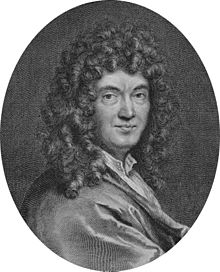Claude Perrault
Claude Perrault | |
|---|---|
 Engraved portrait of Perrault by Gérard Edelinck | |
| Born | 25 September 1613 Paris |
| Died | 9 October 1688 (aged 75) Paris |
| Education | Doctor of Medicine |
| Alma mater | University of Paris |
| Occupation | architect, physician, writer |
Notable work | Louvre |
| Relatives | Charles Perrault (brother) Pierre Perrault (brother) |
Claude Perrault (25 September 1613 – 9 October 1688) was a French architect, best known for his participation in the design of the east façade of the Louvre in Paris. He also achieved success as a physician and anatomist, and as an author, who wrote treatises on physics and natural history.[1]
Biography[]
Perrault was born and died in Paris. Aside from his influential architecture, he became well known for his translation of the ten books of Vitruvius, the only surviving Roman work on architecture, into French, written at the instigation of Colbert, and published, with Perrault's annotations, in 1673. His treatise on the five classical orders of architecture followed in 1683. As physician and natural philosopher with a medical degree from the University of Paris, Perrault became one of the first members of the French Academy of Sciences when it was founded in 1666.
A committee commissioned by Louis XIV, the Petit Conseil, comprising Louis Le Vau, Charles Le Brun, and Perrault, designed the east façade of the Louvre.[2] It was begun in 1668 and was almost completed in 1680, by which time Louis XIV had abandoned the Louvre and focused his attention on the Palace of Versailles. The wing behind the east façade was not finished until the 19th century with the advent of Napoleon. The definitive design of the east façade is attributed to Perrault, who made the final alterations needed to accommodate a decision to double the width of the south wing.[3]
The east façade, divided in five parts, is a typical solution of the French classicism. The simple character of the ground floor basement sets off the paired Corinthian columns, modeled strictly according to Vitruvius, against a shadowed void, with pavilions at the ends. Little that could be called Baroque can be identified in its cool classicism that looks back to the 16th century. Perrault's participation in its design established his reputation as an architect.
Perrault also built an Observatory, the church of St-Benoît-le-Bétourné, designed a new church of Ste-Geneviève, and erected an altar in the Church of the Little Fathers, all in Paris. Perrault's design for a triumphal arch on Rue St-Antoine was preferred to competing designs of Le Brun and Le Vau, but was only partly executed in stone. When the arch was taken down in the 19th century, it was found that the ingenious master had devised a means of so interlocking the stones, without mortar, that it had become an inseparable mass.
In addition, he made a valuable contribution in acoustics. His treatise on sound was a part of the book Oeuvres diverses de Physique et de Mecanique. In his later book, he treats such subjects as sound media, sources of sound and sound receivers. In musical acoustics, he noted the importance of vibration on consonance and dissonance. His study "De la Musique des Anciens" in the Oeuvres diverses discussed how combinations of notes yields harmony. It also contains critical examinations of old manuscripts on European music.
His brother, Charles Perrault, is remembered as the classic reteller of the old story of Cinderella among other fables.
Bibliography[]
- Du bruit; et De la musique des anciens : extrait des Oevres diverses de physique et de mécanique (tome 2); et Préface manuscrite du Traité de la musique de Claude Perrault (Bibl. Nat. manuscr. fr. 25,350) by Claude Perrault; François Lesure; Bibliothèque nationale de France
Notes[]
References[]
- Ayers, Andrew (2004). The Architecture of Paris. Stuttgart; London: Edition Axel Menges. ISBN 9783930698967.
- Mémoires pour servir à l’histoire N=naturelle des animaux (Memoirs for a natural history of animals: containing the anatomical descriptions of several creatures dissected by the Royal Academy of Sciences at Paris).
- Introduction by Alberto Pérez-Gómez to Indra Kagis McEwen's translation of Perrault's Ordonnance for the five kinds of columns after the method of the Ancients. Santa Monica, CA : Getty Center for the History of Art and the Humanities, 1993.
- Herbermann, Charles, ed. (1913). . Catholic Encyclopedia. New York: Robert Appleton Company.
External links[]
 Media related to Claude Perrault at Wikimedia Commons
Media related to Claude Perrault at Wikimedia Commons- Works by Claude Perrault at Project Gutenberg
- Works by or about Claude Perrault at Internet Archive
- 1613 births
- 1688 deaths
- Deaths from sepsis
- Architects from Paris
- 17th-century French architects
- French zoologists
- French Baroque architects
- 17th-century French physicians
- French architecture writers
- Members of the Académie royale d'architecture
- Members of the French Academy of Sciences